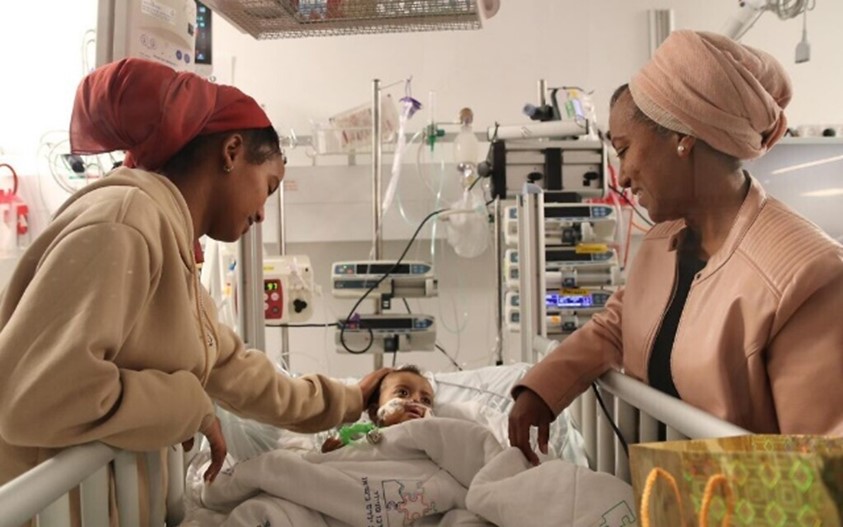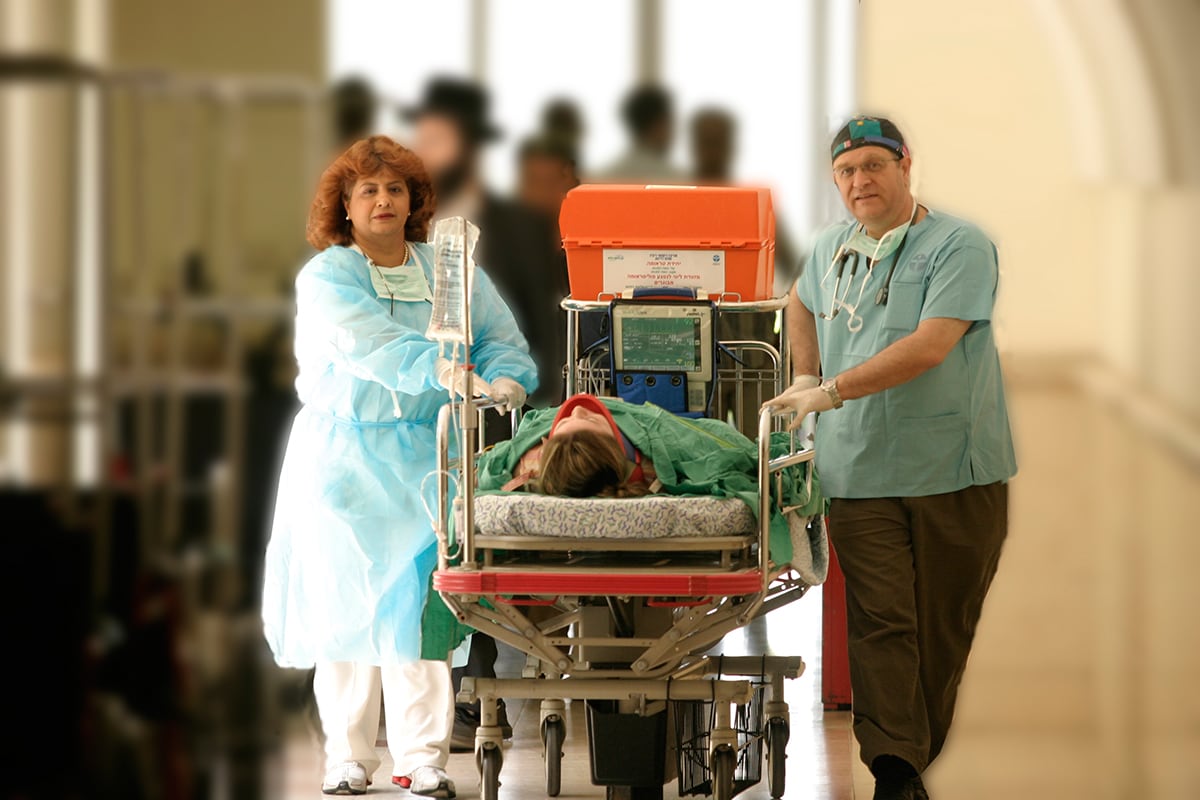American Friends of Rabin Medical Center
We support innovative medical treatment and healthcare at Israel’s Rabin Medical Center for one million patients annually. Partnering with the hospital, we promote the best care, research and technology to reach new frontiers in global medicine. We facilitate international medical fellowships with individual and corporate support for the hospital.
AN URGENT PLEA FROM DR. FELIX BENNINGER AT ISRAEL'S RABIN MEDICAL CENTER
Dr. Felix Benninger, Deputy Director, Department of Neurology, has an emergency plea from Israel's Rabin Medical Center during this horrific war.
FALLEN ISRAELI SOLDIER DONATES ORGANS AND SAVES SIX LIVES AT RABIN MEDICAL CENTER

Ayelet Samo (right) meets 9-month-old Tehila and her mother at Schneider Children's Medical Center on November 20, 2023.
(Photo courtesy of Schneider Children Medical Center)
Staff Sergeant Yehonatan Yitzchak Samo was brought to Rabin Medical Center from Gaza with critical wounds. Sadly, Staff Sergeant Samo could not be saved. However, he left a legacy by donating his organs, which will enable six patients to live.
Staff Sergeant Yehonatan Yitzchak Samo from Carmei Tzur recently passed away at the Rabin Medical Center in Greater Tel Aviv, after succumbing to injuries he suffered in combat in Northern Gaza.
Thanks to Staff Sergeant Samo, doctors were able to save the lives of six people, including an eight-month-old infant who received the lifesaving transplant of his donated liver lobe.
The infant’s mother told the fallen soldier’s mother, “I am so moved. I don’t have the words to thank you. My little girl has been born again thanks to your son.”
A family member said, “On his own accord, Yehonatan pledged himself as an organ donor ... There wasn’t a moment’s doubt about whether to donate his organs. That was just like Yehonatan. He approached everything with a smile, an understanding heart, unwavering commitment, and an innate desire to assist others.
The fact that a portion of him will live on, continuing to aid others, is a truly uplifting thought. During the traditional shiva mourning period, his selfless act inspired many to pledge as organ donors, and we believe more will follow suit.”
Important Updates
Israel's Rabin Medical Center Newly Opened Rehabilitation Center Is The Future Of Healthcare
Dr. Michael Bahar, Rabin Medical Center's Director of the newly created Rehabilitation Department dedicated to war casualties, outlines how this war has changed the future of rehabilitation and post-op therapy.
Update from Dr. Leor Perl, Rabin Medical Center Department of Cardiology
“It has been, indeed, a historically testing time for us – as all Israelis and Jews throughout the world have felt in different ways.
War injuries can lead to epileptic seizures
Rabin Medical Center in Greater Tel Aviv has been receiving war casualties from both the north and south, and Dr. Felix Benninger, deputy director of the neurology department and epilepsy specialist at Rabin Medical Center has noted an increase of soldiers with head injuries developing epileptic symptoms.
In the face of adversity and war, Israel’s Rabin Medical Center of Petach Tikvah stands as a pillar of strength. Rabin Medical Center’s Emergency and Trauma Center is the largest in the Middle East, one of only six Level One ER and trauma centers in Israel, and a pillar of defense for Israel’s security.
DONATE HERE TO SUPPORT THE EMERGENCY & TRAUMA CENTER AS IT SAVES LIVES

Recent Global Connections with Robert Siegel
AMERICA-ISRAEL PARTNERSHIP – LEADER & CELEBRITY TRIBUTES
Cardinal Timothy Dolan, Archbishop of New York:
“…that the Catholic archbishop of New York would be honored by an acclaimed hospital in Israel reflects the touching and tender climate of religious amity that radiates from this city. That Christians, Jews, Moslems, and representatives of so many diverse creeds would come together in fun, fellowship, and support of a healing center in Tel Aviv is a tribute to a religious freedom and respect for belief that is not to be taken lightly, since in most parts of the world where such an event would be thought science fiction.”

New Jersey Governor Phil Murphy:
“President John F. Kennedy is one of my heroes. And, it is he who said about Israel: “It is the child of hope … it has not been a Jewish cause – any more than Irish independence was solely the concern of Americans of Irish descent.”
I cannot think of any institution which better exemplifies this statement than the Rabin Medical Center, nor any American organization which lives this maxim than the American Friends.
Millions of people – of all faiths and all nationalities – have walked through the doors of the Rabin Medical Center with the understanding that they will be treated with dignity, by some of the best medical staff, and in one of the most-advanced health-care settings in the entire world.
The doors of the Rabin Medical Center are doors of hope.”
New York Governor Kathy Hochul:
“[Rabin Medical Center] truly also embodies the vision of someone I followed closely as a child, someone who dominated the news all the time. [ Prime Minister Yitzhak Rabin] was an extraordinary individual who had a vision that we could provide services regardless of religious background, ethnicity or where people came from, that everybody was entitled to quality healthcare.
We want to make sure that people living everywhere, particularly in Israel, have access to quality healthcare, high quality healthcare at Israel’s Rabin Medical Center serving over a million people a year. And the workers there are extraordinary individuals who are filled with such compassion for their fellow man and woman, and what we saw during this pandemic was an outpouring of that love despite the risks. They showed up day after day after day, and for that we honor them. But to simply call people heroes doesn't seem like enough.
Davidoff Cancer Center Expansion
The Davidoff Cancer Center, opened in 2005, is the leading oncology center in Israel and the Middle East, treating 130,578 patients last year. Funded through the vision and generosity of the Davidoff Family and Davidoff Foundation, the hospital provides for renowned cancer experts from major hospitals abroad with funded fellowships. Due to the Center’s high demand since its establishment, a major expansion will be completed in 2022 with six new floors added to the Davidoff Center to facilitate the increased patient load. The Davidoff Center has become a place of healing for all Israelis and calls upon your support to facilitate this vital expansion.

Help Us...
Our YouTube Channel
Facts & Figures
Recent Annual Statistics for Rabin Medical Center

|
1,000,000 Annual Patient Visits 200,000 ER Admissions 35,000 Surgical Procedures 20,000 Patients Daily 10,000 Births 7,000 Staff Members 1,100 Patient Beds + 500 COVID-19 Beds 290 Organ Transplants 120 Bone Marrow Transplants 50 Research Laboratories |

Rabin Medical Center Statistics


|
200,000 ER Admissions 10,000 Births 35,000 Surgical Procedures 290 Transplants |

Cancer Care and Treatments at Rabin Medical Center

|
71,785 Outpatient Visits 56,912 Radiation Therapy Visits 50,175 Radiation Therapy Treatments 37,502 Chemotherapy Treatments 10,124 Integrative Medicine Unit Visits |

Cardiac Care at Rabin Medical Center

|
4,228 Hospitalizations 3,316 Cardiac Catheterizations 808 Cardiothoracic Surgeries 716 Pacemakers and Heart Rhythm Procedures 82 Trans-catheter Valve Interventions |

Raphael Recanati Genetics Institute Care at Rabin Medical Center

|
52,034 Genetic Screenings 22,350 Genetic Consultations 2,454 Genetic Chip Tests 357 Pre-Implantation genetic testing done |

Helen Schneider Women’s Hospital Care at Rabin Medical Center


|
24,900 Emergency Room Visits 22,000 Ultrasounds Performed 20,256 Maternity Emergency Room Visits 10,207 IVF Clinics Performed 9,123 Outpatient Clinics Performed |

Sign Up for Email Updates










